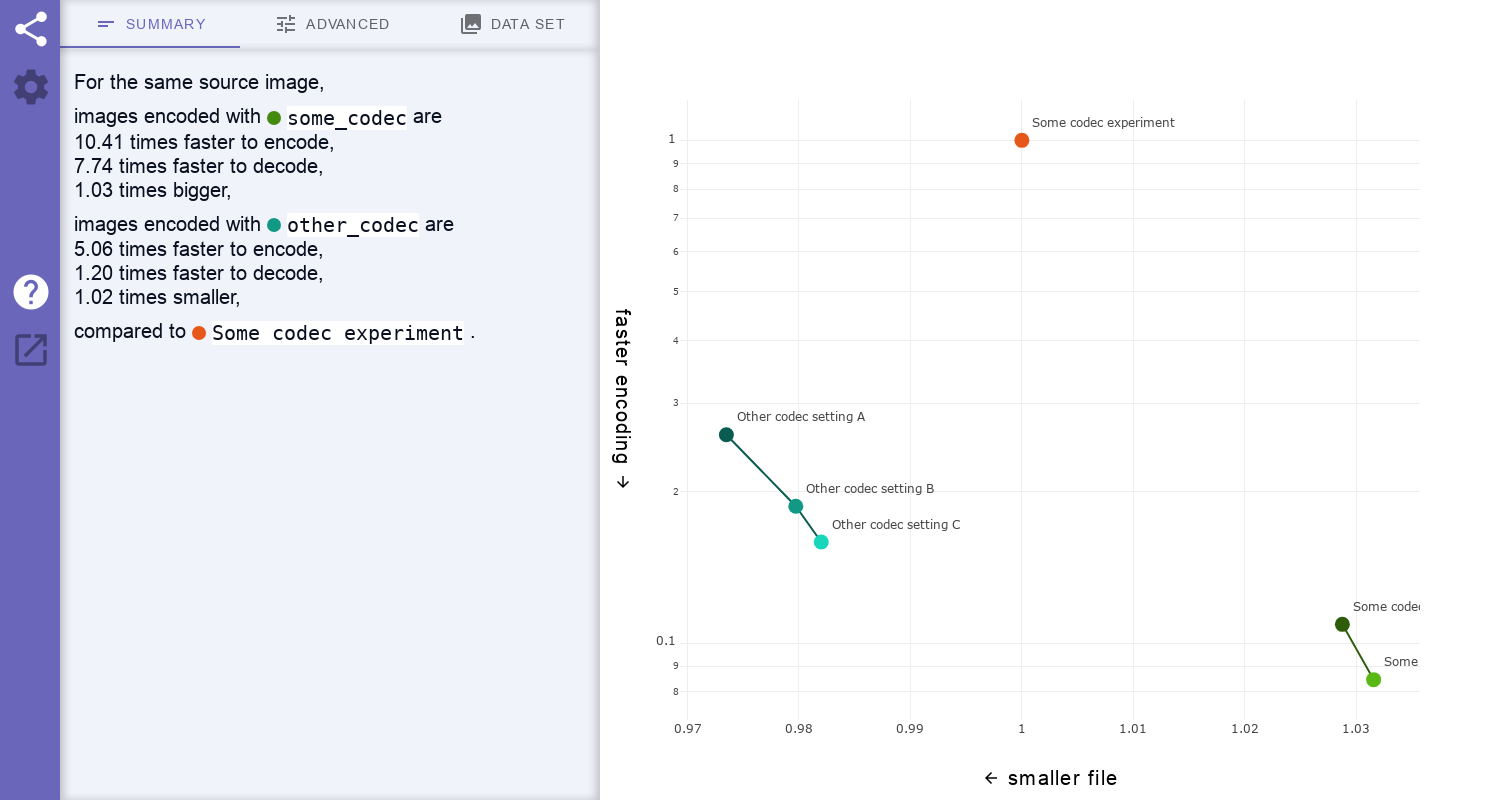Codec-Compare is a static front-end framework presenting and aggregating performance data, in order to compare the codecs that were used to generate that data.
Input data is expected to be in JSON format. It is aggregated based on some fields used as matchers. Stats are computed and plotted for the fields selected as metrics:
The intent is a tool that is both novice-friendly, so that anyone landing on the page can understand what is shown, but also useful to experts, by offering a convenient interactive user interface with matcher, metric and filter settings. The presented data should be easily reproducible and up-to-date.
In contrast to more traditional comparative benchmarks, Codec-Compare aims to aggregate statistics after comparing pairs of two similarly encoded images, to avoid some of the bias brought by comparing already aggregated metrics. Most absolute metrics heavily depend on the dimensions and content of the source image and may not reflect the strengths of a codec when averaged; relative metrics can bring another perspective, at the expense of a reduced data point count due to discarded unmatched encoded images.
Feel free to file an issue for any question, suggestion or bug report. Contributions are also welcome, see CONTRIBUTING.
Follow these instructions after cloning this repository to build the static framework.
Install npm: https://docs.npmjs.com/downloading-and-installing-node-js-and-npm
From the project root directory, install the project's dependencies:
npm installTo build and immediately view the framework in a browser:
npm run devTo only build:
npm run buildFiles are generated in dist/. They can be served as is, for example with
npm run preview (from root folder) or python3 -m http.server (from dist/
folder).
Codec-Compare has:
- A main landing page
index.html. - An image viewer
visualizer.html. - Typescript
web components
in
src/. - A dependency on Lit.
- A dependency on Plotly.js.
- A dependency on Material Web Components.
- A dependency on Material Icons.
- Graphical assets and demo placeholders in
assets/. - A
package.jsonproject configuration file (used bynpm install). - A
tsconfig.jsonTypeScript configuration file (used bynpm run devandnpm run build). - A
vite.config.jsVite configuration file (used bynpm run devandnpm run build). - A
karma.conf.jsKarma configuration file (used bynpm run test).
Note: See
https://lit.dev/docs/components/properties/#avoiding-issues-with-class-fields
for why useDefineForClassFields is set to false in tsconfig.json.
For each batch of data, format it as the following JSON pattern:
{
"constant_descriptions": [
{"codec": "Name of the codec used to generate this data"},
{"version": "Version of the codec used to generate this data"},
{"time": "Timestamp of when this data was generated"},
{"<Any other constant name>": "<Any other constant description>"}
],
"constant_values": [
"<Name of the codec, such as 'libavif'>",
"<Version of the codec, such as 'v1.2.3' or git hash 'abc0123'>",
"<Timestamp, such as '2020-02-02T12:34:56'>",
"<Any other constant value>"
],
"field_descriptions": [
{"<Any field name>": "<Any field description>"},
{"<Another field name>": "<Another field description>"},
{"<Another field name>": "<Another field description>"}
],
"field_values": [
["<Value of first field of first row>", 0, "<Value of third field of first row>"],
["<Value of first field of second row>", 0, "<Value of third field of second row>"]
]
}This JSON structure mostly uses arrays ("ordered collections of values" according to json.org) instead of objects ("unordered sets of name/value pairs") to make sure the description order matches the value order.
See this demo file for a full example.
Reference each of these batches in a single top-level list with the following JSON pattern:
[
["path/to/some/batch/entries.json"],
["path/to/other/batch/entries.json"]
]Serve these alongside the generated web files and point to
index.html?load=path/to/json_list.json.
See the wiki for an example bash script that generates data for AVIF, WebP and JPEG XL to be displayed in Codec-Compare:
https://github.com/webmproject/codec-compare/wiki/Generate-AVIF,-WebP,-JPEG-XL-data-(bash-script)
See the Apache v2.0 license file.
